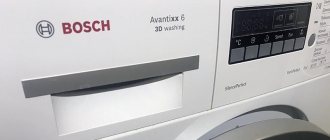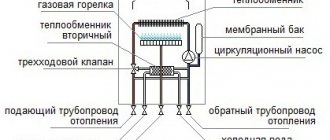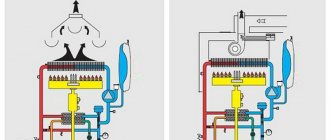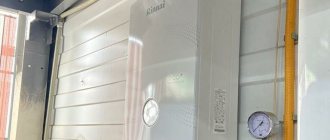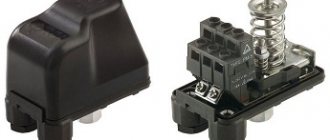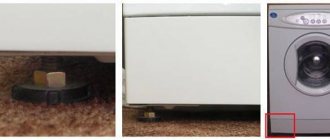But eliminating most of them yourself is quite possible. And this will allow you to save about 60 - 70% on repair services.
But with the purchase of components, as a rule, there are no problems. Many of their spare parts are generally compatible with 10 – 20 models of washing machines.
How does an automatic washing machine work?
Conventionally, a washing machine can be divided into the following units:
- Electrical engine . Converts electric current into rotation of the drum pulley, where dirty laundry with water and detergent is placed.
- Drum. Located in a sealed “capsule”.
- heating element. Responsible for heating water to a given temperature. Also equipped with a temperature sensor.
- Pump. Pumps dirty water into the sewer.
- Valve. Installed on the inlet hose. Distributes water, supplying it to the drum, as well as to the detergent compartment.
- Control block. Controls the operation of all units. The washing programs are “wired” in it.
- Sensor block. Each washing machine has several of them: temperature, pressure switch (water level sensor in the drum), hatch lock sensor (checks whether the door is tightly closed and also locks it until the end of the wash). Some washing machines also have a gyroscope or accelerometer, with the help of which the control unit monitors the strength of vibrations during spinning.
- Shock absorption system. The drum inside the washing machine is installed on shock absorbers and is held on top by a weight, which dampens about 80–90% of all vibrations.
Naturally, technically there are some differences between washing machines from different manufacturers.
For example, flagship models from Samsung also have an aerator installed, which fills the water with air bubbles, which makes it possible to more effectively remove stains on clothes and linen, but with minimal risk of tissue damage.
And Electrolux has a “silent” washing mode. In this case, the entire cycle takes longer, but during operation the equipment produces minimal noise (less than 72 dB).
Keys
Forgetfulness is an understandable human trait, but forgetting your keys in your pocket is definitely not a good idea. If we are talking about car keys, you should understand that water is dangerous, because the mechanism will inevitably suffer. In addition, like coins, keys can damage the inside of the car and ruin the drum. Repairing such a breakdown is very expensive! Always check pockets before putting items in the wash. Even if your keys are dirty, you definitely shouldn't clean them in the car.
Damages that you can fix yourself
The most common washing machine breakdowns encountered in everyday life:
- The wash does not start after pressing the “Start” button on the control panel.
- The washing machine does not fill with water.
- The water does not drain after the end of the wash cycle.
- The drum does not spin during washing and an error message is shown on the display.
- The water does not heat up, regardless of the temperature specified in the settings.
- The washing machine leaks during washing.
- Spin does not work or extraneous noise occurs during spinning.
The wash does not start
Recommended actions:
- Check that the hatch is tightly closed. The door is equipped with a special sensor. If it recognizes that the hatch is not closed, it will not be able to start the wash. This is a precaution to prevent water leakage.
- Check to see if the water supply shut-off valve is open and if there is any water in it at all. It is also recommended to check the water pressure in the pipe. To start the wash cycle normally, it must be at least 0.4 bar (and for washing machines from Bosch - 0.5 bar or higher).
- Turn off and turn on the washing machine after 5 minutes. It is possible that the control unit has malfunctioned. That is, you will need to reboot it. It is recommended to temporarily disconnect the washing machine from the network - this ensures that the installed controller is reset to factory settings.
- If the washing machine does not respond at all to pressing the buttons, then the control panel may be broken. Keys, as a rule, have plastic holders, which often break. The control panel needs to be replaced.
The washing machine does not take in water.
The first thing you need to do is check the presence of water in the water supply (as well as the pressure).
Also, eliminate kinks in the water intake hose. Then:
- Check if there is a blockage in the mesh filter of the water intake hose. To do this, you need to unscrew it from the coupling (first turn off the water supply). Afterwards, remove the filter. If there is a blockage, rinse it thoroughly under running water . If the filter is damaged, it is recommended to replace it. You can purchase it at any hardware store.
- Check the functionality of the water intake valve.
To check the valve, you will need to remove the back wall of the washer. The valve is located at the top (near the coupling to which the water intake hose is screwed). Several thin tubes extend from it: one directly into the drum, the second into the detergent compartment.
To check the valve you will need to remove it. Carefully remove the hoses, as well as the power connector. For diagnostics you will need a multimeter. It is enough to “ring” the valve contacts - there should be no short circuit between them.
The water does not drain after the end of the wash.
This may not indicate a malfunction of the drainage pump (pump), but also an incorrect placement of the drain hose or a blockage in it.
Recommended actions:
- Remove the drain hose, check for blockages, and rinse thoroughly.
- Install a new hose (if there is a spare one). It is important to maintain its correct location. The outlet pipe is located at the bottom. A drain hose is connected to it, then attached to the top of the washing machine (there is a special plastic holder for this purpose). And only after this the outlet of the drain hose is directed into the sewer (connection through a sealing collar).
- If after all these steps the water still does not drain, this indicates a pump malfunction. As a rule, at the end of the wash, clicks are heard - this is the pump relay turning on.
How to drain the water if the washing machine is broken? You can use the filter drain hole (located at the front). Some washing machine models also have an emergency drain hose there. More information about a specific washing machine in this regard can be obtained in the technical instructions.
The drum does not spin during washing.
Most often it indicates a malfunction of the control unit, failure of the sunroof lock sensor (it can also fail), as well as a loose or broken electric motor drive belt.
Recommended actions:
- Restart the washing machine. Disconnect from the power supply for 15–20 minutes, then repeat the wash cycle.
- Remove the back wall and check the belt. If it falls off, replace it or use a new one. To remove the belt, it may sometimes be necessary to spin the engine (to relieve tension). It also needs to be replaced when cracks appear.
- Check the functionality of the door lock sensor. As a rule, if it fails, the corresponding error is displayed on the digital display.
Leaking from the washing machine during washing
Recommended actions:
- Check that the drain and water intake hoses are securely fastened.
- Check that the drain filter hole is securely closed.
- If the leak occurs through the hatch, the sealing lip will need to be replaced.
The spin does not work or the drum does not spin up to maximum speed.
In most cases, this indicates either a stretched belt, a failed drum drive bearing, or a breakdown of the electric motor.
It is quite possible to replace a belt or motor yourself at home. You only need to disassemble the washing machine from the back and replace the necessary components. But if the bearing fails, you will only have to contact a service center.
Replacing a bearing is one of the most difficult washing machine repairs.
Water does not heat up
The first step is to check whether the temperature setting for washing is set correctly. If in this regard there is complete order, then with a high degree of probability the heating element - the heating element - has failed.
It cannot be repaired and requires replacement:
- Remove the back wall. The heating element is located at the bottom of the drum (there are 2 contacts with terminals, tightened with nuts).
- Unscrew the heating element. Remove the temperature sensor (located between the terminals or slightly below).
- Remove the heating element. Install a new one in its place. Also replace the temperature sensor.
For almost every washing machine, you can choose a heating element with ceramic coating. They are more resistant to scale formation. But such heaters should be handled with care - even a slight scratch on the coating will cause scale to form there.
Required Tools
You can disconnect the machine from the water supply without using tools at all. It all depends on the method of connecting the washing machine to the water supply, as well as on the type of inlet hose of the machine.
Installation and dismantling of the inlet hose is done by hand if there are plastic nuts and fittings at both ends. Plastic parts are fragile and need to be handled without tools.
This type of hose is more common than others. It is supplied complete with washing equipment. However, it is often changed to another.
There may be a metal nut at the end of the hose. It may rust to the pipe or tee. In this case, you will need a wrench of the required size or pliers. Screwdrivers (straight and Phillips) may also be required if the connection is tightened with a clamp.
Features of repairing top-loading washing machines
Technically, such washing machines are designed in a similar way. But it is impossible to turn the drum by hand. The drain pump and electric motor are also located below (attached to the side and bottom walls).
Another difference is the absence of a door lock sensor (locking is not provided there).
In total, you can repair most faults yourself, if you have the proper experience in handling household appliances. The main thing is to carefully follow safety precautions. And it should be noted that independent repairs will void the terms of the warranty.
Coins
It's happened to everyone - in line you get change in coins and don't want to hold up everyone else, so you just put the money in your pocket. Then you put your pants in the wash and notice that the sound is much louder than usual. It makes you remember the change you forgot. Small pieces of metal may seem harmless, but they can cause damage. For example, coins can damage the drain pipe if they pass through the filter. In addition, they can block the drain or even break the glass in the door. The worst thing that can happen is the drum gets damaged. As a result, it will be easier to buy a new car than to repair an old one. Prevent this situation by always checking your pockets carefully.
Prohibited tricks
In order not to cause irreparable harm or damage the washing machine during cleaning, you need to know about several taboos.
- Never wash a machine that is connected to an electrical outlet.
- It is forbidden to wash the washing machine under water pressure, so do not use a spray bottle or shower hose for this purpose.
- Do not use household chemicals that are not intended for cleaning an automatic washing machine.
- The use of abrasive or aggressive cleaning agents such as solvents is prohibited.
- Never clean electrical components yourself, especially the motor. Do not expose them to water.
- Some home craftsmen clean heating elements with sandpaper. Doing this is strictly prohibited!
detailed instructions
At the next stage (as the machine was moved away), find the screws on the back wall that hold the panel that we need to pull off. As a rule, there are two of them: on the right and on the left, but in some devices there is also a third screw located in the center. Using a Phillips screwdriver, completely unscrew the fastener. Plastic washers are installed under the “curly nails”. Be careful to ensure that these small details do not get lost later.
Unscrew the screws to remove the back cover
To remove the top panel, slide it back and lift it up slightly
At the next stage, after completely unscrewing the fasteners, carefully remove the cover. To do this, first move it back (relative to the SMA) and lift it slightly up. Set the panels aside. To later install the cover back, do the same, but in reverse: first align the panel and grooves, and then tighten the fasteners.
This is interesting! If you are familiar with removing side panels from the system unit of a regular PC, then it will be even easier for you. The above steps are no different from dismantling the side panels of a PC.
After access to the internal elements of the MCA is gained, perform a visual inspection or other diagnostic measures. To unlock the door, press the special lock.
Excessive amount of things
It may seem like loading as much stuff into your car as possible is a way to simplify the process. However, if your machine is overcrowded, there is no room for the laundry to move and as a result, items end up unwashed. In addition, excessive load can negatively affect the mechanism. Drum overload is a leading cause of washing machine and dryer failure. Try not to make this mistake and don't overload the machine.
Found a violation? Report content
Typical faults
Before starting repairs, study the structure of the door and the features of its fastening. What problems happen:
- Glass breaks.
- The latch does not work or, on the contrary, gets stuck.
- The support on the hinge breaks.
- The hatch locking device (UBL) does not work.
If the damage is mechanical, you can carry out repairs yourself. But it happens that a failure occurs in the control unit - then the door also does not lock. It is better to entrust the diagnosis and repair of the unit to a professional.
I am myself!
Some modern models of washing machines have a self-cleaning drum function. It cleans the loading tank from debris, wool, hair, threads, etc. that settles during washing. and resembles the idle wash mode.
- A preliminary cleaning stage is activated, similar to a pre-wash.
- After the preparatory stage, the cleaning itself begins, during which the drum rotates at a speed of 50–150 rpm, and the water warms up to 60 0.
- The last step is to rinse, usually twice, and spin at maximum rpm.
The whole procedure takes about one and a half hours. It must be done at least once a month. Of course, the presence of this quality affects the price of the electrical appliance. But the same familiar master, sharing his experience, revealed a secret: this option can be successfully replaced by timely and thorough care.
Small wardrobe items
Children's socks and other small items can get stuck in hard-to-reach places. As a result, you may flood your neighbors due to a clogged filter. It is recommended to wash small items in a special laundry bag. This helps prevent them from becoming deformed and lost, which could endanger the washing machine.
A Brazilian travels 36 km by bike every day to take his loved one home.
It’s good to wash often: myths about shampoo and hair care that only harm
Women's jeans: before you buy them, you need to pay attention to one detail
Pollution prevention measures
A well-known truth: it is easier to prevent than to eliminate the consequences. This also applies to washing machines. To ensure that your automatic machine is always in order, it is enough to follow a few simple recommendations.
- Do not store dirty laundry in the machine's loading tank.
- Empty the drum of washed clothes immediately after the end of the cycle.
- After each cycle, wipe the automatic machine dry, having first disconnected it from the power supply.
- Leave the door open after each wash for ventilation.
- Remember to periodically clean the heating element, drain filter and hose.
- Place the washing machine in a well-ventilated, dry area.
Dangerous mistakes when loading the drum
Let's start with the first stage - loading.
Drum overflowing
A dangerous mistake is overloading the drum. You shouldn’t try to fit as much laundry as possible at one time! It is better to divide things into several washes.
Important! A machine with a full drum will make a lot of noise, vibrate and even jump.
The choice of drum loading option should be made at the purchase stage. After all, a family can grow, and the minimum 3–4 kg is simply not enough. For example, in a machine designed for 5 kg, it will not be possible to wash 5 kg of dry clothes, because when wet, the weight of the clothes increases .
Attention! When washing cotton fabrics and synthetics, the drum should be loaded only 2/3 of the volume, when washing woolen items - half the volume.
Foreign objects
The entry of foreign objects into the drum along with laundry can not only lead to scratches, but also cause damage to machine parts. In addition, delicate fabrics can also deteriorate.
Therefore, before loading laundry, you should carefully check and empty the pockets, and also fasten all the fittings.
Important! The most common problem is coins, paper clips and even keys left in trouser pockets.
Washing small items without a bag
For the same reason, it is necessary to use special bags for small items such as socks, shoelaces and panties. They can cause the mechanism to jam.
Running shoes
Regular running shoes are quite safe to machine wash, however, trying to wash your running shoes can be costly - they may shrink! If the shoes have a label indicating that they are safe to machine wash, simply remove the soles and place the sneakers in separate pillowcases. After this, wash them with towels, which will soften the impact.
Calling a specialist: where to find and how much will it cost?
If you don’t have the time or opportunity to replace the handle yourself, it is recommended to call a professional. You can find a company that specializes in repairing household appliances on the Internet.
It is better to give preference to those companies that have been operating in the market for a long time and value the opinions of customers. This approach to choosing a specialist will help you avoid falling for scammers.
The average cost of work may vary by city and region. The price for the part is not included in the repair price and must be paid separately .
Sometimes it happens that replacing one part does not end the repair. If, along the way, faults are discovered in the device that require elimination, the cost of repairs increases.
In the capital, the average cost of minor repairs is:
- replacement of the hatch handle – from 1,300 rubles;
- door hinge replacement – from 1,200 rubles;
- replacement of sunroof glass – from 1,300 rubles;
- replacement of the entire hatch – from 1,200 rubles;
- opening a hatch without repairs – from 1,000 rubles.
After troubleshooting, the technician provides a guarantee for the work performed.
